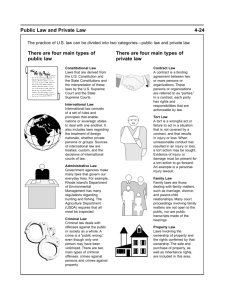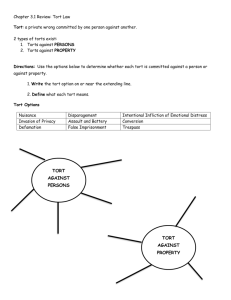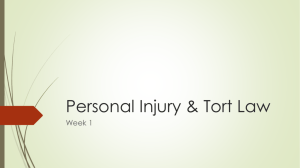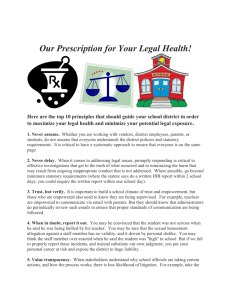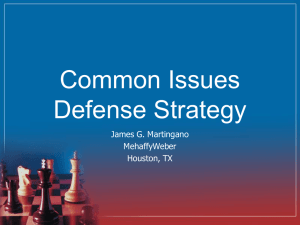Class Actions and Mass Tort Litigation in a Global Context Prof
advertisement
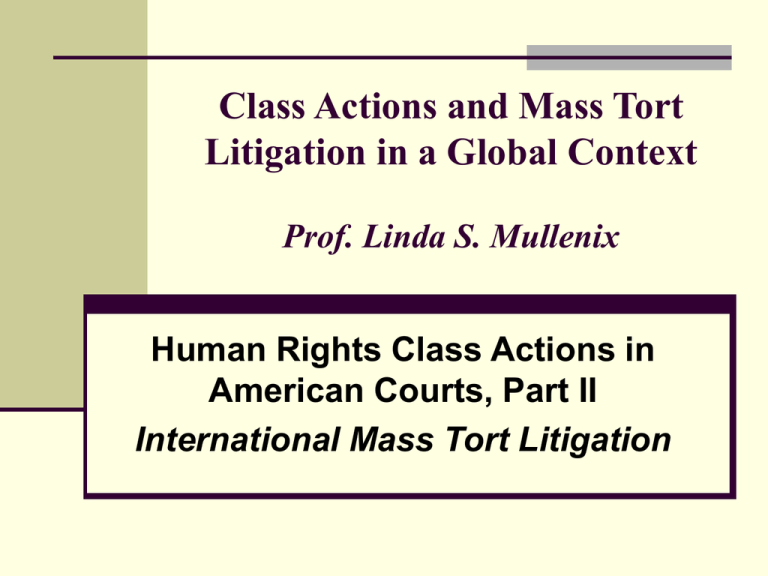
Class Actions and Mass Tort Litigation in a Global Context Prof. Linda S. Mullenix Human Rights Class Actions in American Courts, Part II International Mass Tort Litigation Human Rights Class Actions in American Courts Academic Commentary: Kevin R. Johnson, International Human Rights Class Actions: New Frontiers for Group Litigation, 2004 Mich. St. L. Rev. 643 (2004) Margaret G. Perl, Not Just Another Mass Tort: Using Class Actions to Redress International Human Rights Violations, 88 Georgetown L.J. 773 (2000) Human Rights Class Actions in American Courts Questions: What are the views of Prof. Johnson and Ms. Perl relating to the use of the class action rule for resolving international human rights violations? What positive benefits do they discuss? What problems, if any, to implementing an American-style class action rule for international human rights violations? Human Rights Class Actions in American Courts Prof. Johnson (theses): Views human rights litigation as emergence of novel form of social justice litigation Discusses examples of Yugoslavia litigation, Hilao, and Holocaust recovery litigation Forces that have expanded scope of litigation: Growing use of class actions for social reform in the United States Class action favorite tool for social reformers in the United States Globalization of the international political economy Human Rights Class Actions in American Courts Prof. Johnson (theses): Class actions challenge notion that litigation is only between private parties Class actions challenge concept of national borders and state sovereignty Class actions that cross national borders deserve greater scrutiny Human Rights Class Actions in American Courts Prof. Johnson (theses): Development of human rights class actions in the U.S.: 1980 decision in Filartiga v. Pena-Irala Reinvigorated use of Alien Tort Claims Act Facilitated bringing civil actions in U.S. courts for human rights abuses in other countries Enactment of the Torture Victim Protection Act Human Rights Class Actions in American Courts Prof. Johnson (theses): New international human rights litigation is natural and logical extension of “impact litigation” in the U.S. Example: class litigation played unique role in immigration law through reforming misconduct by identifying a pattern and practice of illegal behavior Immigration class actions share many characteristics with new international human rights class actions Human Rights Class Actions in American Courts Prof. Johnson (theses): Purposes of international human rights class actions: Damages sought, but unlikely to be recovered However, class action may bring public attention to human rights atrocities: “Indeed, unlike ordinary mass tort class actions, monetary or injunctive relief may not even be expected – or the primary goal – in some cases.” International human rights litigation may comprise part of a larger strategy for social change Holocaust litigation spurred diplomatic settlement between German and U.S. governments Human Rights Class Actions in American Courts Prof. Johnson (theses): “The motivation of the attorneys in international human rights class actions often differs from that of lawyers in mass tort class actions. Attorneys seeking social change are often motivated primarily by political goals, perhaps those of the organization they are affiliated with, as opposed to monetary compensation from a settlement.” Human Rights Class Actions in American Courts Prof. Johnson (theses): Difficulties of International Human Rights Class Actions: Role of the attorney: actions are attorneydriven and class actions may be pursued by attorneys with their own political agendas Courts placed in a more political role than is usual Human Rights Class Actions in American Courts Prof. Johnson (theses): Examples of Bracero class litigation and Mexican repatriation class litigation: Reflected new strategy to call attention to problems Goal to build pressure on Congress for possible political action (hope of reparations) Compensation only part of the reason for lawsuit This characterteistic separates human rights litigation from “garden variety” mass tort cases seeking mega-damages Not Just Another Mass Tort? Human Rights Class Actions in American Courts Margaret G. Perl, Not Just Another Mass Tort: Using Class Actions to Redress International Human Rights Violations, 88 Geo. L.J. 773 (2000) Also comments on Hilao and Karadzic class actions Article written before de-certification of the Karadzic class action Also notes expanded use of human rights class actions resulting from Alien Tort Claims Act and Torture Victims Protection Act Human Rights Class Actions in American Courts Perl (theses): American federal courts should use more liberal standards for class certification when presented with human rights cases Human rights class actions should not be subjected to strict analysis applied to mass tort cases Courts should take into account purposes of human rights litigation and lack of feasible alternatives for claimants Human Rights Class Actions in American Courts Perl (theses): Hilao and Karadzic cases demonstrates more lenient approach to class certification than in conventional mass tort cases Easy commonality found in Karadzic case: Questions revolved around acts of the defendant Court satisfied all claims arose out of “ethnic cleansing campaign” Human Rights Class Actions in American Courts Perl (theses): Typicality requirement also easily satisfied in Hilao litigation Court satisfied that class representatives injuries “virtually identical” to those of class – whether victim experienced pain and suffering from torture, execution, or disappearance Appellate court did not find fault with lack of in- depth analysis on predominance and superiority requirements in Hilao Court diverged on strict analysis of manageability required in other mass tort cases Court approved elaborate three-phase trial plan with statistcial damages Human Rights Class Actions in American Courts Perl (conclusions): “There is no principled way to distinguish Marcos and Karadzic from the mass tort precedent to allow for a more lenient application of the Rule 23 requirements except to acknowledge that the substance of the claim matters to courts when crafting their Rule 23 analysis. ATCA and TVPA cases appear to be certified more readily than mass tort despite similar difficulties in meeting Rule 23’s requirements.” Human Rights Class Actions in American Courts Perl (conclusions): “As the number of class actions based on international human rights violations increases in future years, courts should openly recognize the unique policy implications of these cases and resist the urge to treat them as harshly as current mass tort precedent would have them do. This is a principled exercise of judicial discretion under Rule 23 premised on the realization that class actions under the ATCA and TVPA are too distinct from mass tort to be subject to the same assumptions and analysis.” Human Rights Class Actions in American Courts Questions: At the time Perl wrote her article, the Karadzic class action had been certified. The same court, however, subsequently de-certified the class action. Does that change Perl’s analysis and conclusions? Do you agree with Perl that human rights class actions are different than mass tort class actions? Should human rights class actions be subject to easier class certification? Why? Are you persuaded by Perl’s arguments for this position? International Mass Tort Litigation: Two Case Studies In re Ski Train Fire in Kaprun, Austria In re Factor VIII or Factor IX Concentrate Blood Products Litigation International Mass Tort Litigation Questions: What is an international mass tort litigation? Are international mass tort cases different than international human rights violations? Can and should American courts resolve international mass tort litigation? Should international mass torts be handled differently than domestic American mass tort cases? Should different standards apply to international mass tort cases? In re Ski Train Fire in Kaprun, Austria on November 11, 2000 International Mass Tort Litigation In re Ski Fire in Kaprun, Austria: Factual Basis: Funicular train fire in tunnel near Kaprun, Austria, November 11, 2000 155 passengers and crew killed Victims: 92 Austrians 37 Germans 10 Japanese 8 Americans 4 Slovenians 2 Dutch 1 Britain, 1 Czech International Mass Tort Litigation In re Ski Fire in Kaprun, Austria: The Litigation: American family members filed litigation in the U.S. Scattered litigation consolidated under MDL procedures in federal court in New York Plaintiffs sought damages, declaratory, injunctive relief Substantive legal allegations (claims): Tunnels improperly designed, constructed, maintained Negligent operation and promotion Fraudulent misrepresentation of safety Negligent infliction of emotional distress International Mass Tort Litigation In re Ski Fire in Kaprun, Austria: The Litigation: The Defendants: Siemens Corporation, Siemens AG, and multiple other German and Austrian corporate entities and holding companies Manufacturers and operators of the train International Mass Tort Litigation In re Ski Fire in Kaprun, Austria: Procedural Basis: Action brought in the court’s diversity jurisdiction American plaintiffs; foreign defendants Sought class certification under Rule 23(b)(2) and Rule 23(b)(3) Class definition: “on behalf of a class of heirs and representatives of victims of the Kaprun tragedy who consent to be included as members of the class” International Mass Tort Litigation Questions: Do the facts of the Kaprun train fire present the type of situation that should be handled through class action litigation? What problems are presented by this proposed class action? Should the court certify this class? Why? In what fashion should the court certify this class action? International Mass Tort Litigation In re Ski Fire in Kaprun, Austria: Decision of the trial court judge (Judge Scheindlin): Court certifies the class action for liability issues only (not damage phase of trial) Proposed class satisfied adequacy requirements Proposed class satisfied predominance for a Rule 23(b)(3) damage class Class action superior to other forms of dispute resolution Court orders an “opt-in” class International Mass Tort Litigation In re Ski Fire in Kaprun, Austria: Judge Scheindlin’s decision – Adequacy of Representation: Defendants attack adequacy of class representatives (both class representative and class counsel) Court holds class representative Habblett has standing under Texas law to bring suit as his daughter’s representative, and to represent class members Habblett has sufficient knowledge of the case; appreciates responsibilities as class rep. However, court refuses to permit Habblett to be sole class representative; conditions certification upon naming other class rep. and representative for foreign plaintiffs International Mass Tort Litigation In re Ski Fire in Kaprun, Austria: Judge Scheindlin’s decision – Adequacy of Representation (class counsel): Detailed lengthy discussion of dispute among class attorneys Class attorneys unwilling to work with one another Court canvasses and describes disputes Court orders class certification conditioned upon one attorney being appointed to serve as liaison for foreign (non-American) class members International Mass Tort Litigation In re Ski Fire in Kaprun, Austria: Judge Scheindlin’s decision – Predominance of Common Issues: Class treatment on fraud claim appropriate in this case No variation in representations of safety nor in plaintiffs’ reliance on those representations Same reasoning applies to Ps’ claims for intentional infliction of emotional distress Only individualized issues relate to damages, not to liability issues International Mass Tort Litigation In re Ski Fire in Kaprun, Austria: Judge Scheindlin’s decision – Superiority: Court recognizes traditional reluctance to certify class actions for mass tort cases However, court recognizes “recent” growing recognition that mass accident cases ought to be maintained as class action Class action here would be not only appropriate but also beneficial: Class action limited only to liability All members in same position re Ds: no individualized defenses Little risk that Ps will want to pursue their own claims International Mass Tort Litigation In re Ski Fire in Kaprun, Austria: Judge Scheindlin’s decision – Superiority: “Because the individual class members do not have the wherewithal to individually litigate the defendants’ liability . . . the class action mechanism is the superior method for adjudicating the defendants’ liability.” International Mass Tort Litigation In re Ski Fire in Kaprun, Austria: Judge Scheindlin’s decision – Superiority: “The non-American plaintiffs will be unable to bring their damages actions against the foreign defendants in the United States because there is no diversity jurisdiction over a foreign plaintiff suing a foreign defendant in the United States.” “I recognize that class certification will allow many non-Americans to take advantage of this country’s legal system and its class action device, which is unavailable in many foreign jurisdictions.” International Mass Tort Litigation In re Ski Fire in Kaprun, Austria: Judge Scheindlin’s decision –Opt-In requirement: Opt-in class is necessary in these circumstances Class means that all plaintiffs waive their right to sue Ds in foreign jurisdictions Would be unfair to include members in a class that depends on waiver of a right Requirement to opt-in found in federal fair Labor Standards Act class actions International Mass Tort Litigation Judge Scheindlin’s decision – Opt-In requirement: No prior case law permitting opt-in requirement But, nothing in rule or case law precludes opt-in requirement Judge’s authority to order opt-in procedure derives from judge’s equitable powers Finally, no certification under Rule 23(b)(2) – no additional benefit International Mass Tort Litigation Questions: Is Judge Scheindlin’s class certification of the Kaprun fire victims a good decision? Was her decision a sound application of the class action rule? What do you think about her decision to certify an opt-in class? Why did she do this? Was Judge Scheindlin’s class certification decision upheld on appeal? Is the appellate court’s decision sounder than Judge Scheindlin’s? What are the implications of the appellate decision for the class members and victims of the fire disaster? International Mass Tort Litigation Kern v. Siemens Corp., 393 Fd.3 120 (2d Cir. Dec. 2004)(Appellate Court Decision): Defendants’ appeal of class certification – four challenges: Rule 23 does not permit opt-in provision “all heirs, beneficiaries and personal representatives” is unmanageable class requriring individual inquiries Question use of class action in mass accident Court erred in certifying class with fraud and emotional distress claims (require individual determination) International Mass Tort Litigation Kern v. Siemens (2004): Court reverses class certification Only addresses opt-in provision Rule 23(c) does not permit class certification of opt-out class during liability phase Language of Rule 23 does not provide or permit opt-in procedure Substantial legal authority supports view that providing for opt-out, Congress intended to prohibit opt-in procedure Historical materials by Committee Reporter indicate consideration and rejection of opt-in procedure International Mass Tort Litigation Kern v. Siemens (2004): Rule 23(c) does not permit class certification of opt-out class during liability phase: No federal court has certified opt-in procedure Would be contrary to interests of claimants in small claims class actions Courts hesitant to require opt-in during liability phase Opt-in type procedures (claims forms) possible during damage phase Fair Labor Standards Act opt-in procedure narrowly applies only to labor cases under statute No equitable powers of judge to authorize opt-in procedure International Mass Tort Litigation Final Questions: Does the Second Circuit’s decision in Kern make sense? Could the Kaprun Ski Fire case have been certified as a class action if the judge had not provided for the controversial opt-in provision? Is the Kaprun Ski Fire case the type of situation where an American court should take jurisdiction and resolve the mass accident through the class action litigation? Given the large numbers of non-American victims, should this matter have been handled in a foreign forum, such as Austria? Fine
